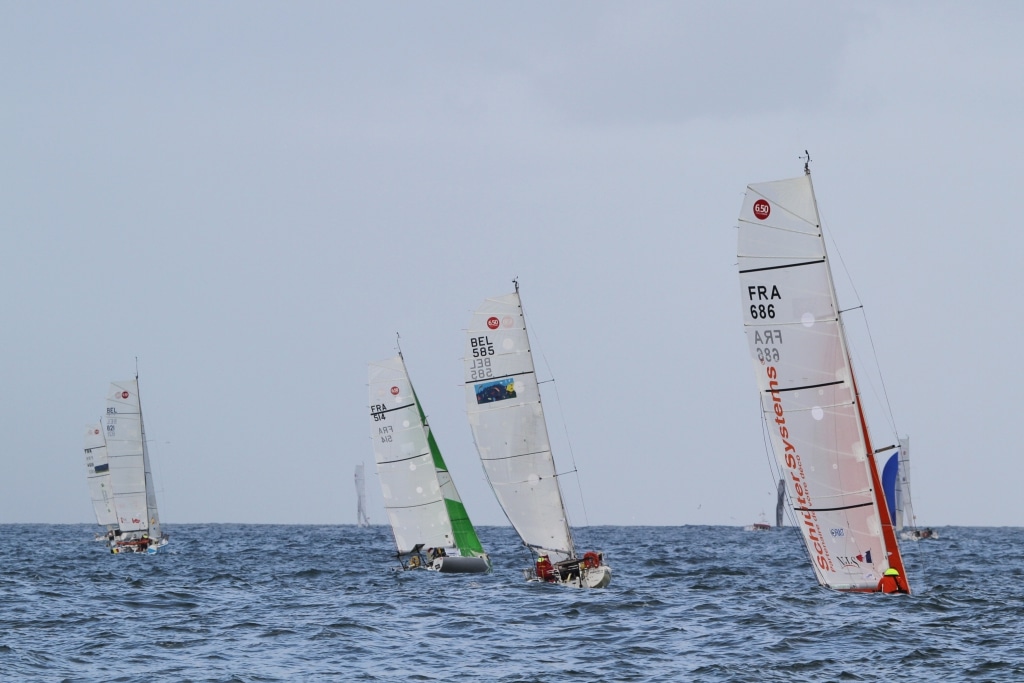
Mini Transat 2013
The insanity was over, at least for now. After beating up and over huge seas in 40 knots of wind on a 6.50-meter Mini Class before a cresting wave knocked down his boat, everything was relatively calm now at the port of Sada, Spain. Sails stored, weather-tracking software checked, toothbrush packed along with just enough provisions needed to survive, he had a few hours to think about the 3,700-mile trek he was about to make across the Atlantic to Pointe-a-Pitre, Guadeloupe.
The man is Raphael Marchant (26). He is one of 84 sailors who signed up to attempt to cross the Atlantic to Guadeloupe in the Mini Transat. Marchant, like the other sailors in the fleet, was diverted to the port in Sada last week when the race was yet again interrupted due to bad weather.
Photo: Bruce Gain
Raphael Marchant said the thrill of sailing alone was one of the reasons he decided to start the Mini Transat campaign. He also said the nights on the water alone can be very dark.
The Controversy
The first time the race was postponed was when the start at Douarnenez, France, was delayed by over two weeks in October. The decision likely prevented a large percentage of the boats from dismasting or worse early on in the race if they had sailed directly into the 50-knot winds blowing nearby–yet many criticized the organizers’ choice. Despite the almost inevitable carnage that would have ensued, there were those who said the race should have begun anyway, since at least some of the boats could have made it through the storm front without dismasting or suffering other major damage.
In the case of Marchant, he was prepared to go the day the start was postponed but knew the odds of what would have happened if the race had gone ahead as planned. “Just being able to stay in the race would have been like winning the lottery, since most of the boats would have been wiped out,” Marchant said. “But I was ready.”
Indeed, the Mini Transat has always been a controversial race because of how dangerous it is perceived to be. To begin with, just the prospect of sailing such a small and light boat, weighing less than 2,000 lbs., alone across the Atlantic with a VHF radio to call for help is a daunting prospect. The organizers do what they can, but the list of incidents that have happened during the past three decades is long, especially before GPS and improvements in weather tracking became available.
On the day before the official start in France, the trepidation could be felt on the dock where Marchant was surrounded by friends and family, including his godfather. The general mood of the crowd was festive yet sober, despite the champagne that flowed profusely during the baptism ceremony for Marchant’s boat.
Marchant’s father was far from thrilled with his son’s project in the beginning, but he helped him as much as he could when he realized that Marchant was set on making the trans-Atlantic trek. As a parent, his son’s adventure will understandably weigh on him until he is safely onshore in Guadeloupe.
Threads of Reason
Still, the sailors and their reasons for doing a transat alone on a tent-sized craft usually seem at least reasonable when you ask them about it directly. A common explanation for taking part in the Mini Transat is how relatively accessible it is compared to other well-known offshore races. For example, it is possible to sail competitively on a one-design Mini on a budget of 60,000 euros all-included, compared to paying several hundred thousand euros to sail competitively in the Route du Rhum or several million euros to have a shot at being a contender in the fabled Vendée Globe.
The Mini Transit is also seen as a rite of passage. Some of the world’s most famous sailors have taken part when first trying to make their mark, including Michel Desjoyeaux and Ellen MacArthur. The competitors are generally more inexperienced compared to those who take part in the larger and much more expensive offshore solo transats such as the Route du Rhum and the Vendée Globe.
But there is always the inherent risk of this race to consider. Even without taking into account the long casualty list of Mini Transats during years past, this year’s race has so far been eventful. More than 12 of the boats have dropped out so far and the race is not even one third of the way over. American Jeffrey MacFarlane, for example, was on one of more than a few boats that dismasted between France and Spain. Already, earlier this year before the race, MacFarlane had to be airlifted off the coast of Spain when he crashed his boat and broke several muscles in his hand.
Those who have abandoned the race certainly did not do so for lack of extreme resiliency, mental toughness, or courage. One such sailor is Australian Katrina Ham (26), who decided to embark on the Mini Transat adventure only a very short while ago. She came to France not much longer than a year before without knowing how to speak French, but somehow secured enough sponsorship money and help to come up with a 50,000 euro budget to take part. While preparing for the race, Ham was knocked overboard in the English Channel at one point and managed to pull herself back onboard.
Disaster struck again hit a few days ago when a cresting wave knocked Ham overboard while she was not wearing her harness near Ribadeo, Spain. She had radioed in to report a problem with her boat’s gooseneck and was waiting for a tow to enter the port when the wave slammed her boat. After a rescue boat retrieved her from the water, Ham was transported to a local hospital where she was treated for hyperthermia. Ham will not make it to Guadeloupe during this race since she was forced to abandon the course, but given her resilience and determination, she will almost certainly be back.
Closer to the start, Arthur Leopold-Léger (28) went overboard as well near Douarnenez. As he was tossed and pulled along in the waves by his harness, he struggled to slow the boat down by putting it into the wind with a remote control device that guided the automatic pilot. He also struggled getting back on board and the boat eventually dismasted before he was rescued by a French coast guard boat that was escorting the fleet.
At end of the first night after leaving Sada, Ian Lipinski’s boat was knocked over, mast pointing vertically into the drink as the cockpit filled up with water. The boat was held upside down with just a 20-inch airspace in total darkness before it finally righted about an hour later. With the helms destroyed and electric power, Lipinski (age 32) fired an emergency flair and made mayday calls on his battery-powered VHF until help arrived. But even when a cargo ship en route to Tunisia came to rescue him, Lipinski barely made it up the ship’s rescue ladder as the large waves crashed him and his boat against the hull.

Photo: Jaques Vapillon/Sea & Co
Ian Lipinski had a 20-inch air space when his boat was knocked down and filled with water.
The list of incidents this year goes on.
Marchant, on the other hand, was a lot luckier when a breaking wave slammed his boat near the port of Sada. “If the wave had been bigger, I would have been swept to the beach and the Mini Transat would have been over for me just like that,’ Marchant said.
The Race Is On–Again
After being criticized for erring on the prudent side by interrupting the race and diverting the fleet to Spain, the organizers decided to remove the planned stopover in the Canary Islands. That way, the entire fleet began to head on a non-stop direct course across the Atlantic to Guadeloupe when the race resumed Wednesday.
Marchant previously sent a message to friends and family when he was between France and Spain, describing how dark it gets in the middle of the night alone on his boat and how he was badly shaken when the wave crashed into his boat hear Sada. Now, he and the rest of the sailors are truly alone, after heading out in the dark and very November Atlantic a few days ago. They hope to catch the tail winds and currents past the Azores that should take them to the sun and palm trees in Guadeloupe in a few weeks.
The controversy over the decisions the race organizers made recently, or most other earthly happenings, for that matter, no longer hold as much weight for those alone on their boats. At some point, you only have yourself to rely on and other things to think about when help can be hundreds of miles of way. Maybe that is what the Mini Transat and sailing offshore alone is really about.









